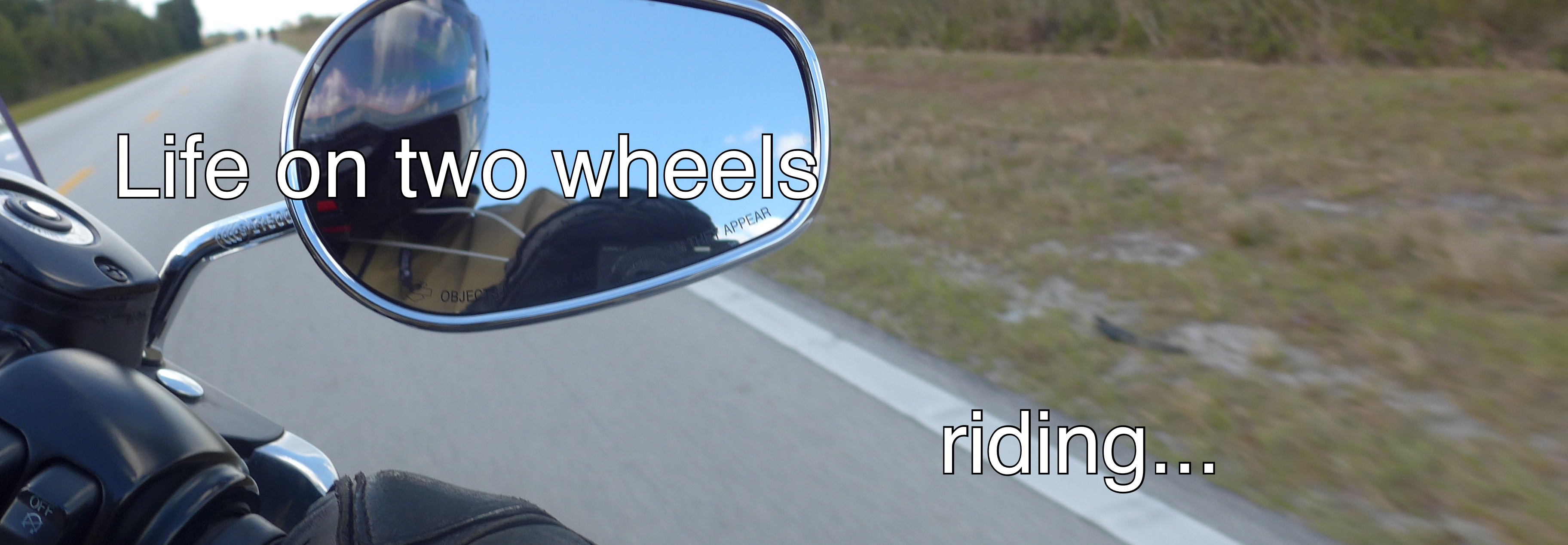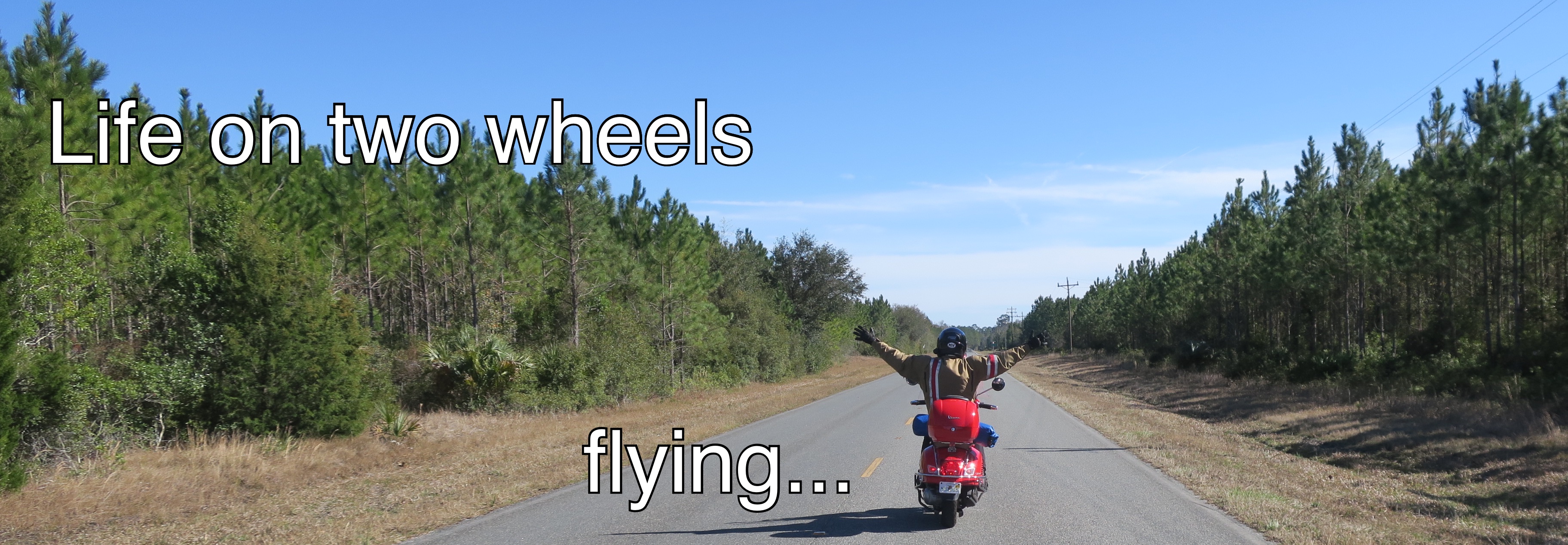Eventually you will want to park your bike somewhere, and not want to schlep your helmet along for your stroll.
If you wear a half helmet or perhaps a three-quarter helmet, and if your pet carrier or top case are relatively empty, you can store your helmet there and it will be out of sight, protected from the elements, and reasonably secure.
If your helmet doesn't fit there, you'll need another strategy. Then again, maybe your helmet would fit there, but, like me, you carry other stuff in those places (rain suit, tool kit, portable air compressor, locks, digital camera, Sham-Wow, RAM mount accessories, monocular spy scope, ear plugs, flattened beer can (indispensable for soft ground to support the stand), air pressure gauge, Iphone charging cable, bungee net, GPS unit, re-usable shopping bags, sunglasses, velcro strap to compress the rear brake when the tire needs air, Icon waterproof gauntlets, and other sundries), and then you won't have room for a helmet, or much other stuff.
Sheesh, I sure do carry a lot of stuff. I'll have to have another listen to George Carlin's inspirational riff on 'stuff'.
You could just lock your helmet to the back wheel, like these brave souls do (I don't know them, I just parked next to them at the mall).
One plus of this strategy is that if a thief takes your scoot, those helmets will smack his leg with each turn of the stolen wheel.
But sitting on the ground like that seems a little inelegant, not to mention that you might get an earful of ants and spiders when you pop your lid back on.
If your helmet strap closes with a double D-ring, like a horse saddle cinch, Vespa's got you covered. It's easy to overlook this tiny feature under the saddle, just at the lip of the pet carrier, on the starboard side, at one'clock.
If you still can't spot it, this picture may well be worth a thousand more words.
Once you close the saddle, the helmet hangs securely from the chin strap.
You might think that the strategies I've covered so far are the only ones you'll need to secure your helmet.
Well, if your helmet is a full-face helmet, and if it has a nice ratchet closure, like mine, then you're still out of luck.
So what do I do?
I'm glad you asked. It took me a while to figure it out.
I picked up a short cable lock at the Montreal Harley Davidson + BMW dealer.
I close the chin-guard on my Nolan N102 helmet, thread the cable lock though the visor opening, pass the cable through the grab rail, and close the lock. I lower the visor, then sit the helmet down on the saddle, up against the topcase.
The nice thing about this strategy is that if it rains while you're off running errands, the inside of the helmet stays nice and dry.
Wait! You say you have an open-face helmet with a ratchet closure? You're still not out of luck. You need to get a T-bar thingy specially made for the Nolan ratchet closure helmet. You thread it through the ratchet, then slip the hole on the T-bar onto the under-seat helmet hook, and close the seat.
There you have it, six sure-fire strategies for securing your helmet, before you set off for a walk in the park.
Showing posts with label Nolan N-102 helmet. Show all posts
Showing posts with label Nolan N-102 helmet. Show all posts
Sunday, August 28, 2011
Tuesday, August 16, 2011
First long distance ride
I did it yesterday.
A road trip from Montreal to Ottawa and back. On my Vespa. I've included a Google Earth view of the trip, mainly because I couldn't figure out how to embed a complete Google map view. I've now figured out that the trip was so long that the result is actually seven Google map segments. There are so many that I've added them to the end of this post.
8 1/2 hours (9:30 a.m to 6:00 p.m.); 375 kilometres, 233 miles; one more province added to the places I've ridden; one $3.00 ferry trip; 6 or 7 bridges; three pit stops to top up with gas; one chat with a fellow rider on a big Beemer who couldn't quite believe a guy on a small-frame Vespa was pacing him; one stop for a bite to eat; one massive traffic jam in Gatineau due to road work; one hour spent visiting my dad; one rush hour in Ottawa; two dozen or so bugs obliterated on my visor; three sets of disposable ear plugs; 75 kms on the Trans-Canada Highway with the throttle twisted to the stop, too few pictures to share, and one numb bum.
That's it for the ride stats.
What did I learn?
Long distance riding is tough. Really tough. The Vespa's gas tank is not designed for long distances. Nor is the saddle or seating position for that matter. 150 cubic centimeters is 100 or so cubic centimeters short for pacing traffic on a straight, two-lane, 90 km/h highway. A mid-height windscreen and a Nolan N-102 helmet is a combination that is WAY TOO LOUD for comfort, even with 32db noise canceling ear plugs.
The sweet spot for the Vespa LX 150 is urban riding. That's where the Vespa really shines. It's fun to ride; it's incredibly nimble; it hauls an incredible range of stuff so it's great for shopping; it can filter through traffic jams like a ghost through walls; you can park it anywhere; it turns heads because it's gorgeous; and the urban riding list goes on, and on.
Which is not to say I didn't have fun on this trip.
The absolute best was a stretch of highway 148 along the Ottawa river in Quebec. It was twisty with good pavement and a speed limit of 80 km/h. Traffic was doing just under 100 km/h. With the throttle wide open, the bike just ate up those sweeping turns. I felt like I was one with the machine, counter steering with just the right pressure on the handle bars, leaning first this way, then that. It was just fantastic.
I also appreciated the elderly gentleman who came up to me after my bite to eat at a roadside hotdog stand, to ask about the Vespa and whether it was made in Italy. He explained to me that the wheels were small because they originally were recycled aircraft landing gear. And I believe he is right.
Crossing from Ile Bizard to Laval on the cable ferry was fun. I hadn't taken that ferry in years.
I also enjoyed stopping at the church in St-Eustache. During the 1837 rebellion the British army laid siege to the church where some of the rebels had taken refuge. You can still see where the wall is pocked by cannon fire. When I was a kid, my mother used to point out a cannon ball that had remained lodged in the wall. That bit must have been repaired at some point, or the cannon ball was dislodged, because it's no longer there.
Visiting my Dad was the reason I went to Ottawa. He loves jackets, so he just had to model my armored BMW Airflow.
At the opposite end of the spectrum, the ride home was not much fun. It was much more about endurance. Highway 17 in Ontario was straight, flat, and fast. The limit was 90 km/h and traffic wanted to do 105 km/h, a tad more than the Vespa LX 150 is able to muster. That stretch of road is a two-lane highway with few passing opportunities. The result was that for some stretches I was leading a parade.
Relief from that misery came when Highway 17 merged with 417 which is the Trans-Canada Highway. For some reason the slight head wind went away and I was able to average about 100 km/h. With traffic able to pass me in the other lane it was actually much more comfortable. It also helped that the opposing traffic on the west bound lanes was on the far side of the very wide median instead of being in the lane right next to me.
Between the 17 and the 417, the return trip ended up being a wide-open-throttle affair pretty much all the way. To be honest I was getting concerned about the impact on the Vespa's 150cc Leader engine. The good news is that after I turned off the motor when I stopped to gas up for the last leg home, the bike started right up without a fuss after the five minute respite.
Would I do it again?
375 kilometers is a lot of ground to cover with any vehicle, let alone a Vespa. And yet, if you look at the links on the right of the page, you'll find many accounts of cross continental trips on Vespa LX 150s, and even on 50cc bikes. I was always impressed with those exploits. Now with my own experience, I am in awe of those incredible trips. Any thought I might have had that I could go coast to coast on my Vespa is receding pretty quickly from my mind.
I might try another long trip if I upgrade to a GTS though. The larger motor would have eliminated the anxiety of not being able pace the traffic.
And before any longish trips are planned, I need to rethink my gear. I need to get a new windscreen and cut it only slightly down so I can see over it and eliminate the noisy turbulence. I also need a much quieter helmet. Not having to contend with that drumming in my ears for hours on end would also have made a huge difference.
Here are those Google maps. The route I took is indicated by the blue trail on the map. There appears to be some kind of a bug with the embedding code, and the route may not be visible on the thumbnail of the map. Scrolling around, or zooming out will reveal the route. I include these maps in the interest of completeness, in case anyone wants a more detailed closer look at the trip.
Flash forward: The Vespa LX 150 was my first Vespa. In 2013 I stepped up to a Vespa GTS 300 i.e. and in July of 2013 managed an epic tour through the northeast. Click here or on the 'Touring' link above, to learn more.
View Ottawa-trip in a larger map
View Ottawa-trip in a larger map
View Ottawa-trip in a larger map
View Ottawa-trip in a larger map
View Ottawa-trip in a larger map
View Ottawa-trip in a larger map
View Ottawa-trip in a larger map
A road trip from Montreal to Ottawa and back. On my Vespa. I've included a Google Earth view of the trip, mainly because I couldn't figure out how to embed a complete Google map view. I've now figured out that the trip was so long that the result is actually seven Google map segments. There are so many that I've added them to the end of this post.
8 1/2 hours (9:30 a.m to 6:00 p.m.); 375 kilometres, 233 miles; one more province added to the places I've ridden; one $3.00 ferry trip; 6 or 7 bridges; three pit stops to top up with gas; one chat with a fellow rider on a big Beemer who couldn't quite believe a guy on a small-frame Vespa was pacing him; one stop for a bite to eat; one massive traffic jam in Gatineau due to road work; one hour spent visiting my dad; one rush hour in Ottawa; two dozen or so bugs obliterated on my visor; three sets of disposable ear plugs; 75 kms on the Trans-Canada Highway with the throttle twisted to the stop, too few pictures to share, and one numb bum.
That's it for the ride stats.
What did I learn?
Long distance riding is tough. Really tough. The Vespa's gas tank is not designed for long distances. Nor is the saddle or seating position for that matter. 150 cubic centimeters is 100 or so cubic centimeters short for pacing traffic on a straight, two-lane, 90 km/h highway. A mid-height windscreen and a Nolan N-102 helmet is a combination that is WAY TOO LOUD for comfort, even with 32db noise canceling ear plugs.
The sweet spot for the Vespa LX 150 is urban riding. That's where the Vespa really shines. It's fun to ride; it's incredibly nimble; it hauls an incredible range of stuff so it's great for shopping; it can filter through traffic jams like a ghost through walls; you can park it anywhere; it turns heads because it's gorgeous; and the urban riding list goes on, and on.
Which is not to say I didn't have fun on this trip.
The absolute best was a stretch of highway 148 along the Ottawa river in Quebec. It was twisty with good pavement and a speed limit of 80 km/h. Traffic was doing just under 100 km/h. With the throttle wide open, the bike just ate up those sweeping turns. I felt like I was one with the machine, counter steering with just the right pressure on the handle bars, leaning first this way, then that. It was just fantastic.
I also appreciated the elderly gentleman who came up to me after my bite to eat at a roadside hotdog stand, to ask about the Vespa and whether it was made in Italy. He explained to me that the wheels were small because they originally were recycled aircraft landing gear. And I believe he is right.
Crossing from Ile Bizard to Laval on the cable ferry was fun. I hadn't taken that ferry in years.
I also enjoyed stopping at the church in St-Eustache. During the 1837 rebellion the British army laid siege to the church where some of the rebels had taken refuge. You can still see where the wall is pocked by cannon fire. When I was a kid, my mother used to point out a cannon ball that had remained lodged in the wall. That bit must have been repaired at some point, or the cannon ball was dislodged, because it's no longer there.
Visiting my Dad was the reason I went to Ottawa. He loves jackets, so he just had to model my armored BMW Airflow.
Relief from that misery came when Highway 17 merged with 417 which is the Trans-Canada Highway. For some reason the slight head wind went away and I was able to average about 100 km/h. With traffic able to pass me in the other lane it was actually much more comfortable. It also helped that the opposing traffic on the west bound lanes was on the far side of the very wide median instead of being in the lane right next to me.
Between the 17 and the 417, the return trip ended up being a wide-open-throttle affair pretty much all the way. To be honest I was getting concerned about the impact on the Vespa's 150cc Leader engine. The good news is that after I turned off the motor when I stopped to gas up for the last leg home, the bike started right up without a fuss after the five minute respite.
Would I do it again?
375 kilometers is a lot of ground to cover with any vehicle, let alone a Vespa. And yet, if you look at the links on the right of the page, you'll find many accounts of cross continental trips on Vespa LX 150s, and even on 50cc bikes. I was always impressed with those exploits. Now with my own experience, I am in awe of those incredible trips. Any thought I might have had that I could go coast to coast on my Vespa is receding pretty quickly from my mind.
I might try another long trip if I upgrade to a GTS though. The larger motor would have eliminated the anxiety of not being able pace the traffic.
And before any longish trips are planned, I need to rethink my gear. I need to get a new windscreen and cut it only slightly down so I can see over it and eliminate the noisy turbulence. I also need a much quieter helmet. Not having to contend with that drumming in my ears for hours on end would also have made a huge difference.
Here are those Google maps. The route I took is indicated by the blue trail on the map. There appears to be some kind of a bug with the embedding code, and the route may not be visible on the thumbnail of the map. Scrolling around, or zooming out will reveal the route. I include these maps in the interest of completeness, in case anyone wants a more detailed closer look at the trip.
Flash forward: The Vespa LX 150 was my first Vespa. In 2013 I stepped up to a Vespa GTS 300 i.e. and in July of 2013 managed an epic tour through the northeast. Click here or on the 'Touring' link above, to learn more.
View Ottawa-trip in a larger map
View Ottawa-trip in a larger map
View Ottawa-trip in a larger map
View Ottawa-trip in a larger map
View Ottawa-trip in a larger map
View Ottawa-trip in a larger map
View Ottawa-trip in a larger map
Thursday, July 8, 2010
Heat
 We Montrealers spend the winter months bundled up against the cold. Add a stiff wind and a drop in winter temperatures, and many of us have experienced minus 40 Celsius. The only thing that's convenient about minus 40 Celsius, is that you don't have to convert it to explain to people who only understand Fahrenheit how cold it might be, because it also happens to be minus 40 Fahrenheit.
We Montrealers spend the winter months bundled up against the cold. Add a stiff wind and a drop in winter temperatures, and many of us have experienced minus 40 Celsius. The only thing that's convenient about minus 40 Celsius, is that you don't have to convert it to explain to people who only understand Fahrenheit how cold it might be, because it also happens to be minus 40 Fahrenheit.We are now gripped in the third day of the reverse: a record-snapping heat wave: For Montreal that means well above 30 Celsius (40+ when you factor in the Humidex, 86 degrees for you Fahrenheit folks). Everyone is now moaning about the heat.
Not me. And I'm riding my Vespa morning and night to commute downtown. Morning is cool(er). Late afternoon is another story. And I'm wearing a black full face Nolan helmet, a Corazzo 5.0 armoured jacket, gloves, heavy Levis, and stout Tyrol hiking boots. That gear will keep you warm on a crisp fall day at 60 km/h.
So why am I not complaining? It's a really good question for all you folks on the air-conditioned commuter train chatting about how unbearably hot it is, while I glide along the lakeshore in my portable human oven get-up.
That's another measure of just how much I enjoy my scoot commute, and how committed I am to the (relative) safety of the experience.
 Last night on the commute back home at about 6:40 p.m., I stopped to take the photos you see here. You can see the heat shimmering in the photos if you look closely enough.
Last night on the commute back home at about 6:40 p.m., I stopped to take the photos you see here. You can see the heat shimmering in the photos if you look closely enough.The guy on the kite-board and I, we have the right recipe. Follow your passion. It means you're cool, even when the weather isn't.

Tuesday, May 11, 2010
Windmills
Another sunny but thoroughly chilly morning. Barely 3 degrees, just above freezing, a light frost on the cars in the driveway at 7:00 a.m. as I fired up the Vespa. I am wearing a fleece under the Corazzo 5.0 jacket and ski gloves on my hands. The visor on my Nolan N-102 is snapped firmly shut.
I stopped to snap this picture of one of the points that reach into Lake St-Louis along the route.
 Scenes like that are a big part of the pleasure that the scoot commute affords.
Scenes like that are a big part of the pleasure that the scoot commute affords.
When I pulled up a wheelchair ramp and onto the sidewalk to park for that shot, I heard a scrape and clunk. Checking the scoot revealed that the kick stand had grazed the curb. The impact shaved the cupped foot off the right leg of the stand.
I've noticed on Modern Vespa that many people name their scooters.
The smartest people I know always bestow names on their cars. I have never personally felt compelled to name my rides.
I was once tempted to name my bicycle ( I thought I would call it "Bernie" for reasons I won't explain, nothing to do with heat or fire). Oddly, I still think of it as Bernie, but frankly, I think that I never actually uttered the name, and this is definitely the first time I am sharing that. It's just not that relevant or important to me.
It occurred to me though, as I rode on and thought about the consequences of the missing foot (can't park on soft ground safely? What, if anything, to do about it?), that a fitting name for the Vespa would be "Peg Leg". I've now posted that on one of the Modern Vespa threads about scooter names. Now that I've thought that, this Vespa will always be "Peg Leg", even if I never actually utter its name.
When I got to the Lachine Canal today, I chose to continue along the river instead of taking the usual route along the canal.
Intuitively I figured that the alternative route would be substantially longer and tack an extra 30 minutes on the ride.
Assumptions are frequently wrong. It turns out that the time penalty for the longer route is only about ten minutes.
Continuing to follow the road along the water brings fresh pleasures. New sweeping views of the lake and the broad St-Lawrence rendered in shimmering silver by the morning light, and new interesting landmarks to admire like the Fleming Mill in Lasalle. The Fleming Mill was built in 1827 and operated until 1891. It now belongs to the City of Lasalle and is a classified cultural monument.
The Fleming Mill was built in 1827 and operated until 1891. It now belongs to the City of Lasalle and is a classified cultural monument. The view of the lake across the road from the mill is truly beautiful and restful.
The view of the lake across the road from the mill is truly beautiful and restful.
I stopped to snap this picture of one of the points that reach into Lake St-Louis along the route.
 Scenes like that are a big part of the pleasure that the scoot commute affords.
Scenes like that are a big part of the pleasure that the scoot commute affords.When I pulled up a wheelchair ramp and onto the sidewalk to park for that shot, I heard a scrape and clunk. Checking the scoot revealed that the kick stand had grazed the curb. The impact shaved the cupped foot off the right leg of the stand.
I've noticed on Modern Vespa that many people name their scooters.
The smartest people I know always bestow names on their cars. I have never personally felt compelled to name my rides.
I was once tempted to name my bicycle ( I thought I would call it "Bernie" for reasons I won't explain, nothing to do with heat or fire). Oddly, I still think of it as Bernie, but frankly, I think that I never actually uttered the name, and this is definitely the first time I am sharing that. It's just not that relevant or important to me.
It occurred to me though, as I rode on and thought about the consequences of the missing foot (can't park on soft ground safely? What, if anything, to do about it?), that a fitting name for the Vespa would be "Peg Leg". I've now posted that on one of the Modern Vespa threads about scooter names. Now that I've thought that, this Vespa will always be "Peg Leg", even if I never actually utter its name.
When I got to the Lachine Canal today, I chose to continue along the river instead of taking the usual route along the canal.
Intuitively I figured that the alternative route would be substantially longer and tack an extra 30 minutes on the ride.
Assumptions are frequently wrong. It turns out that the time penalty for the longer route is only about ten minutes.
Continuing to follow the road along the water brings fresh pleasures. New sweeping views of the lake and the broad St-Lawrence rendered in shimmering silver by the morning light, and new interesting landmarks to admire like the Fleming Mill in Lasalle.
 The Fleming Mill was built in 1827 and operated until 1891. It now belongs to the City of Lasalle and is a classified cultural monument.
The Fleming Mill was built in 1827 and operated until 1891. It now belongs to the City of Lasalle and is a classified cultural monument. The view of the lake across the road from the mill is truly beautiful and restful.
The view of the lake across the road from the mill is truly beautiful and restful.
Subscribe to:
Comments (Atom)
The copyright in all text and photographs, except as noted, belongs to David Masse.


















